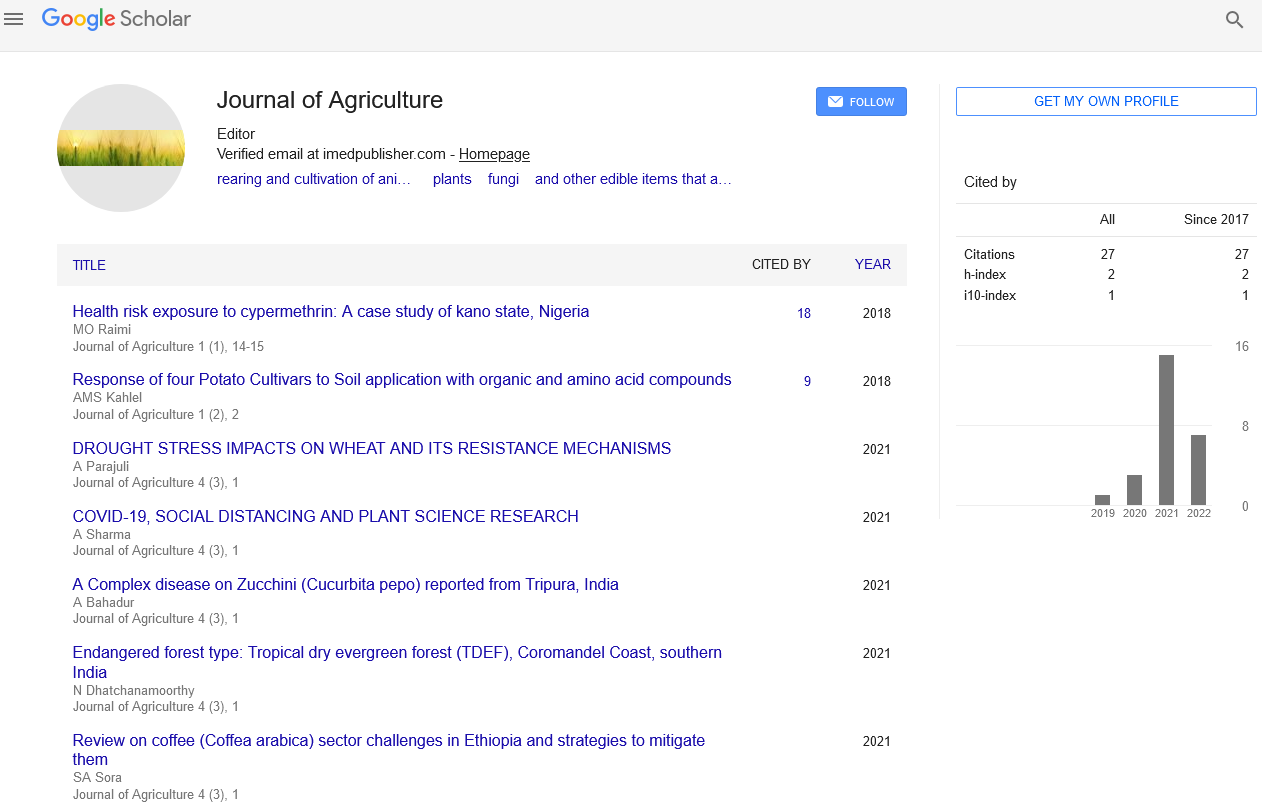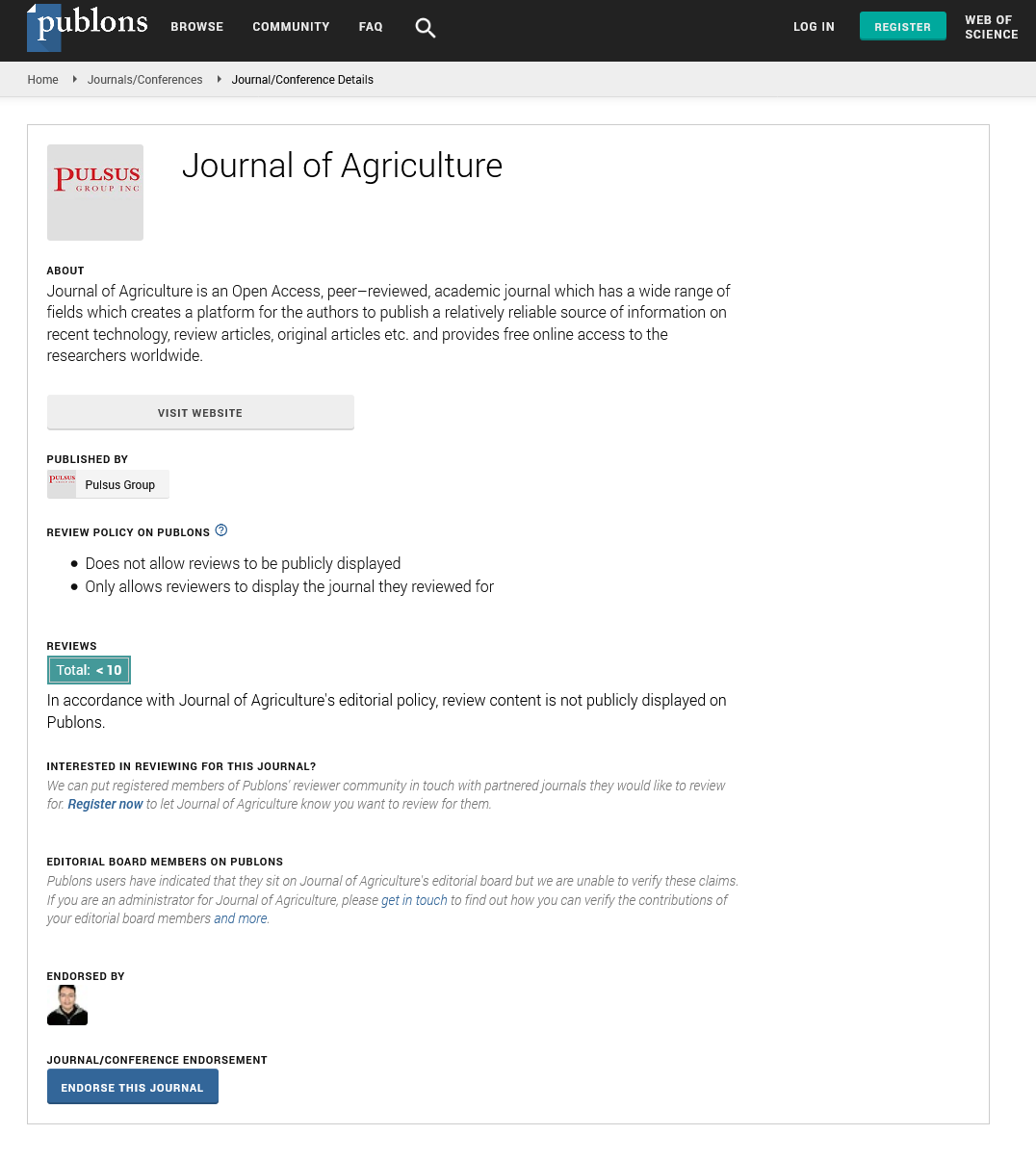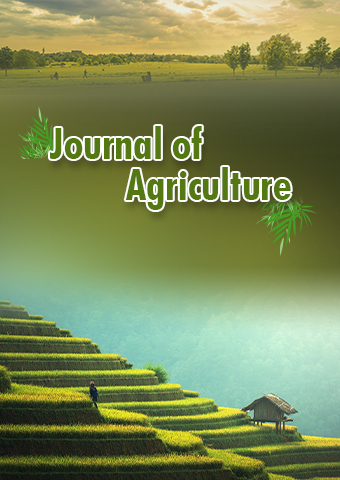Mini Review - Journal of Agriculture (2023) Volume 6, Issue 3
Providing for Food Security: A Global Priority
Rohon Vedi*
Department of Agriculture, Agricultural University, India
Department of Agriculture, Agricultural University, India
E-mail: vedirohon25@gmail.com
Received: 31-May-2023, Manuscript No. jagri-23-103203; Editor assigned: 02-Jun-2023, Pre-QC No. jagri-23-103203 (PQ); Reviewed: 16- Jun-2023, QC No. jagri-23-103203; Revised: 21-Jun-2023, Manuscript No. jagri-23-103203 (R); Published: 28-Jun-2023, DOI: 10.37532/ jagri.2023.6(3).73-75
Abstract
accessibility, and utilization of safe and nutritious food for all individuals, ensuring their physical and economic well-being. In a world grappling with a growing population, climate change, limited natural resources, and social inequalities, achieving and maintaining food security has become increasingly challenging. The multifaceted dimensions of food security, highlighting key factors that influence its attainment It explores the complex interplay between agricultural production, trade, economic stability, environmental sustainability, and social equity as critical components of ensuring food security at the global, national, and local levels. The significance of sustainable agricultural practices It discusses the importance of enhancing productivity while minimizing environmental impact through innovative technologies, responsible land management, and resilient farming systems. Emphasizing the need for diverse and resilient crop varieties, it highlights the role of genetic diversity and sustainable farming techniques in mitigating risks posed by climate change and other agricultural challenges. The crucial role of food systems It recognizes the importance of empowering small-scale farmers, particularly women, and improving their access to resources, markets, and financial services. It advocates for reducing post-harvest losses, enhancing storage and transportation infrastructure, and strengthening local food markets to ensure fair and affordable food distribution. The significance of trade and policy frameworks in achieving food security It emphasizes the importance of fair trade agreements, reducing trade barriers, and promoting sustainable and responsible practices in global food systems. It also underscores the need for coherent policies that address the social, economic, and environmental dimensions of food security, fostering integrated approaches across sectors such as agriculture, health, education, and social welfare. The abstract highlights the importance of nutrition-sensitive approaches to food security.It emphasizes the need to prioritize access to diverse and nutritious diets, especially for vulnerable populations such as children, pregnant women, and the elderly. It underscores the role of education, awareness, and social safety nets in promoting healthy eating habits and tackling issues of malnutrition and food-related diseases. The significance of international collaboration and partnerships in addressing global food security challenges. It emphasizes the need for collective action, knowledge sharing, and technology transfer to support developing countries in building resilient and sustainable food systems. It also recognizes the importance of research, innovation, and capacity building to address emerging issues and develop context-specific solutions. Achieving food security requires a comprehensive and integrated approach that encompasses sustainable agricultural practices, equitable food systems, supportive policies, nutritionsensitive approaches, and international cooperation. Addressing food security challenges requires proactive measures at multiple levels to ensure a sustainable and resilient future where no individual goes hungry, and all have access to safe, nutritious, and culturally appropriate food.
Keywords
Food security • Environmental impact • Agricultural challenges
Introduction
Food security is a fundamental human right and a critical component of sustainable development. It refers to the availability, accessibility, and affordability of nutritious food for all individuals, ensuring their physical and economic well-being. Despite significant progress in agricultural productivity and technological advancements, food insecurity remains a pressing global challenge. This article examines the complexities of food security, its underlying causes, and the measures being taken to address this crucial issue.
Understanding food security
Food security encompasses four essential dimensions: availability, access, utilization, and stability.
Availability: Sufficient quantities of food must be produced to meet the demand of a growing global population. This requires sustainable agricultural practices, adequate natural resources, and investment in research and development [1].
Access: All individuals should have physical and economic access to food. Factors such as income levels, infrastructure, transportation, and market systems play crucial roles in ensuring equitable distribution.
Utilization: Access to food alone is insufficient; it must also be nutritionally adequate and safe for consumption. Promoting balanced diets, proper food processing, and adequate sanitation are essential for optimal utilization [2].
Stability: Food security necessitates consistent access to food over time, regardless of shocks or disruptions such as natural disasters, conflicts, or economic crises. Building resilience in agricultural systems and social safety nets is critical [3].
Causes of Food Insecurity
Poverty: Poverty is a significant underlying cause of food insecurity. Limited financial resources prevent individuals from accessing an adequate and nutritious diet [4].
Climate change: Increasingly unpredictable weather patterns, rising temperatures, and extreme events pose challenges to agricultural production. Climate change impacts crop yields, water availability, and the overall stability of food systems [5].
Conflict and displacement: Areas affected by conflict and mass displacement face severe disruptions to food production, distribution, and access. These crises lead to heightened vulnerability and food insecurity among affected populations [6].
Inefficient agricultural practices: Outdated farming techniques, lack of infrastructure, limited access to technology, and poor land management practices can hamper agricultural productivity and compromise food security.
Addressing Food Security
Sustainable agricultural practices: Promoting sustainable and climate-resilient agricultural practices, such as agroforestry, organic farming, and precision agriculture, can enhance productivity while minimizing environmental impact [7].
Social safety nets: Implementing social safety nets, including cash transfers, food vouchers, and school feeding programs, can help alleviate immediate food insecurity and support vulnerable populations [8].
Enhancing infrastructure: Investment in rural infrastructure, including transportation networks, irrigation systems, and storage facilities, improves market access and reduces post-harvest losses.
Research and development: Continued investment in research and development is vital for improving crop varieties, enhancing agricultural techniques, and addressing emerging challenges such as climate change and pests [9].
International cooperation: Collaborative efforts among governments, international organizations, and civil society are crucial for sharing knowledge, coordinating policies, and providing assistance to countries facing food security challenges [10].
Conclusion
Achieving global food security requires a multi-faceted approach that addresses the underlying causes of food insecurity. It demands sustainable agricultural practices, social protection programs, investment in infrastructure, and international cooperation. As we move forward, it is essential to prioritize the needs of the most vulnerable populations and ensure that food security remains at the forefront of global agendas. By working together, we can build a future where no individual goes to bed hungry, and everyone has access to safe, nutritious, and affordable food.
References
- Zhao J, Li M, Gu D et al. Involvement of rice histone deacetylase HDA705 in seed germination and in response to ABA and abiotic stresses.Biochemical and Biophysical Research Communications.470, 439-444(2016).
- Anderson JW, Ward K. High-carbohydrate, high-fiber diets for insulin-treated men with diabetes mellitus. Am J Clin Nutr. 32, 2312-21 (1979).
- TA, Hayes TR, Cranmer AC et al. Genetic engineering of a quantitative trait: metabolic and genetic parameters the accumulation of laurate in rapeseed. The Plant Journal. 9, 229-241(1996).
- Lusser M, Parisi C, Plan D et al. Deployment of new biotechnologies in plant breeding.Nature biotechnology.30, 231-239(2012).
- Isman MB. Botanical insecticides: for richer, for poorer. Pest Manag Sci. 64(1), 8-11 (2008).
- Nyirenda SP, Sileshi GW, Belmain SR et al. Farmers’ ethno-ecological knowledge of vegetable pests and pesticidal plant use in Northern Malawi and Eastern Zambia. Afr J Agri Res. 6, 2 (2011).
- Anderson JW, Ward K. High-carbohydrate, high-fiber diets for insulin-treated men with diabetes mellitus. Am J Clin Nutr. 32, 2312-21 (1979).
- Schwartz SE, Levine RA, Weinstock RS et al. Sustained pectin ingestion: effect on gastric emptying and glucose tolerance in non-insulin-dependent diabetic patients. Am J Clin Nutr. 48, 1413-7 (1988).
- Anderson JW, Ward K. High-carbohydrate, high-fiber diets for insulin-treated men with diabetes mellitus. Am J Clin Nutr. 32, 2312-21 (1979).
- Roberts CK, Won D, Pruthi S et al. Effect of a short-term diet and exercise intervention on oxidative stress, inflammation, MMP-9, and monocyte chemotactic activity in men with metabolic syndrome factors. J Appl Physiol. 100, 1657-65 (2006).
Indexed at, Google Scholar, Crossref
Indexed at, Google Scholar, Crossref
Indexed at, Google Scholar, Crossref
Indexed at, Google Scholar, Crossref
Indexed at, Google Scholar, Crossref
Indexed at, Google Scholar, Crossref
Indexed at, Google Scholar, Crossref
Indexed at, Google Scholar, Crossref


